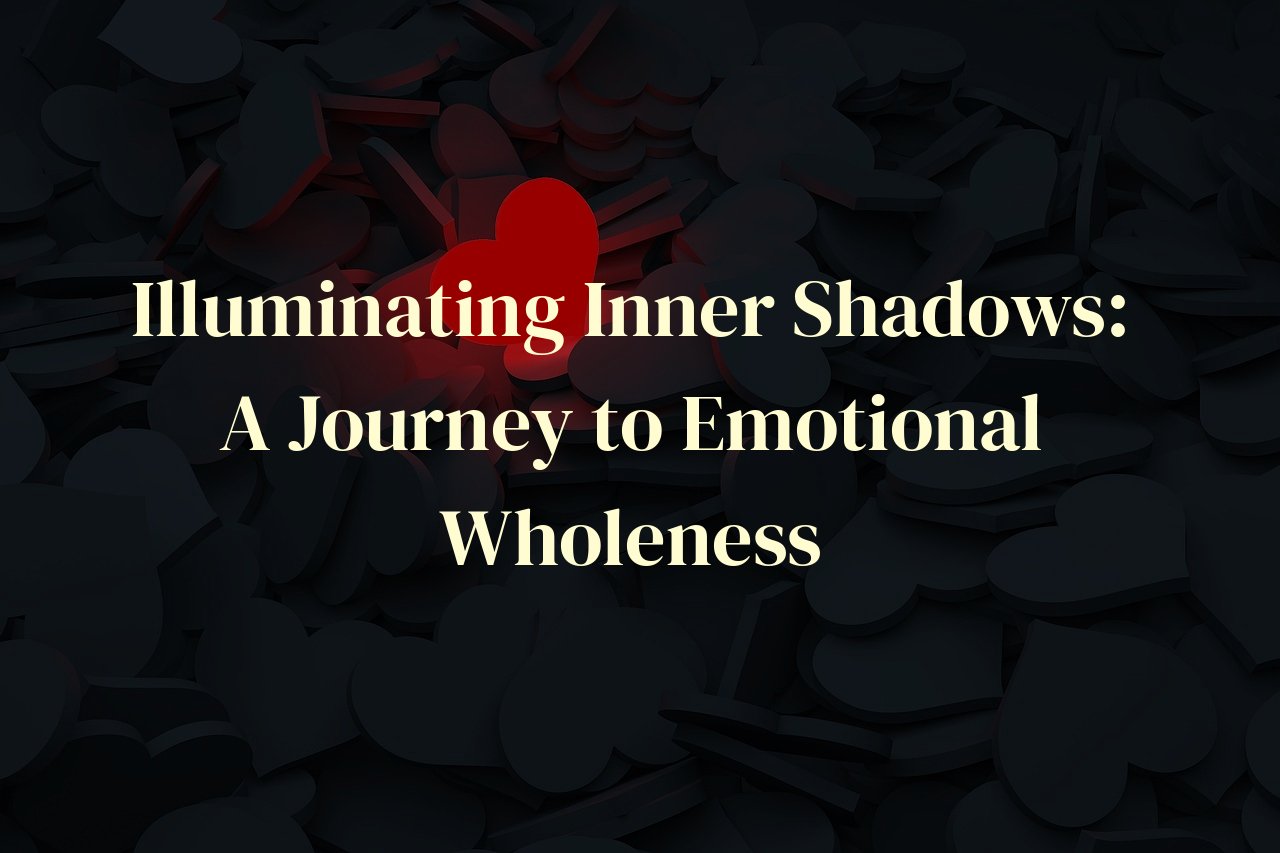
Navigating the realms of our inner landscape, we often encounter elements that seem to dim the luminosity of our emotional well-being. This blog post illuminates a transformative process known as shadow work, which promises to brighten these obscured corners of our psyche. By exploring the intricate bond between confronting our subconscious and nurturing mental health, we embark on a path to comprehensive wellness.
Readers will receive valuable insights into harnessing the power of shadow work to enhance emotional balance. The practices outlined herein are drawn from both professional expertise and personal encounters with the subtle art of self-discovery. Learn how embracing your full self, including the parts you often hide or dismiss, can lead to a more fulfilling and emotionally sound life.
Table of Contents
Unveiling the Shadow: Exploring Our Hidden Emotional Depths
The quest to understand our innermost selves often leads us down paths untrodden, through the vast and murky realm of the subconscious. The concept of the shadow, introduced by Swiss psychiatrist Carl Jung, refers to those aspects of our personality that we choose to repress or hide from both ourselves and the world. In unveiling the shadow, we’re not just looking for monsters lurking in the dark crevices of our minds; rather, we dive deep to discover hidden treasures of untapped potential and parts of ourselves that have been denied expression.
Through my journey of shadow work, I’ve learned that our shadows are facets often forged in pain, trauma, or societal expectations. They become the home to not just negative traits like rage or envy but also to sources of creativity, intuition, and deep-seated desires. By exploring our hidden emotional depths, we encounter the silenced voices within us, opinions we’ve smothered, and talents we’ve buried beneath layers of self-doubt or fear of judgment.
Shadow exploration is not for the faint-hearted. It demands courage, persistence, and a willingness to confront uncomfortable truths. In my own experience, I’ve unearthed emotions tightly interwoven with past experiences—threads of sorrow from losses un-mourned, sparks of anger over boundaries once crossed, and flickers of joy from passions I had set aside. As we reveal these facets to ourselves, we come to see our shadow not as an enemy but a guide, pointing us toward a more authentic and whole version of ourselves.
Yet, the revelation of the shadow is not an end but a beginning. This discovery sets the stage for integration, where we take these once fragmented parts and weave them into the fabric of our being. By acknowledging the existence of these hidden dimensions, we initiate a dialogue between our conscious mind and the unconscious, fostering a relationship that can enhance our emotional intelligence and overall psychological health.
The Role of Shadow Work in Personal Growth and Healing
The term ‘shadow’ in psychological context refers to the aspects of ourselves that we have pushed into the recesses of our unconsciousness. It’s every trait, impulse, and painful memory we’ve deemed unacceptable and thus, hidden away. Yet buried, they impact our lives in ways we may not comprehend without introspective work. Engaging in shadow work, then, becomes a transformative practice for personal growth and healing.
In my own voyage toward emotional wholeness, I came to recognize that shadow work is anything but linear. It’s a dynamic process that oscillates between moments of profound insight and bewildering confusion. This tumultuous journey, however, is essential for healing. It’s like peeling back layers of an onion, where each layer represents an ingrained belief or a past hurt that has muffled my authentic self.
What I have found particularly poignant in shadow work is its capacity to liberate us from internal conflicts. These conflicts often arise from disowned parts of ourselves, and as we bravely confront our shadow, we start embracing our full identity. This acceptance triggers a cascade of healing, mending fractures within our psyche and bringing about a sense of completeness that we might have thought was beyond our reach.
Furthermore, shadow work paves the way for greater emotional intelligence. By becoming aware of and integrating our darker impulses, we foster deeper empathy for ourselves and others. This, in turn, enhances our interactions and often results in healthier, more fulfilling relationships. It’s a journey that initially seems daunting but ultimately rewards us with a richer, more nuanced emotional life.
Throughout my personal healing journey, shadow work has unlocked doors to self-forgiveness and compassion. Rediscovering these parts of myself, acknowledging them without harsh judgment, has been akin to watching a shattered mirror piece itself back together. The reflection is more honest, wholly me, replete with intricacies that tell a story of resilience and self-discovery. By shining light on the shadows, I have emerged not scarred by them but sculpted by the understanding they provided.
Techniques to Bridge Conscious Awareness and the Unconscious Mind
Navigating the expanse between our waking thoughts and the enigmatic corners of the unconscious can seem like traversing an unbridged chasm. Yet, the art of shadow work offers us a tapestry of techniques to gently weave together these seemingly disparate parts of our psyche. My personal odyssey into the twilight of the subconscious has led me to embrace several transformative practices.
Firstly, meditation has been an invaluable ally. By descending into the tranquility of my inner cadence, I encountered whispers of the concealed self. Those persistent insecurities and dormant desires would surface, at times, like bubbles escaping from the deep seafloor, offering revelations that were as unexpected as they were profound.
Journaling too has been my silent confessor, a medium where my inner dialogues could crystallize into tangible thoughts. The act of writing with unfettered honesty is akin to holding a mirror up to the shadows, urging them to materialize in more relatable forms.
Engaging in dialogue with the unconscious through a practice known to many as ‘Active Imagination’, I have held conversations with different aspects of myself, often startled by the wisdom housed within my own depths. It’s as if by allowing these voices to speak, I am no longer just a singular entity, but a council of many, each with its lessons and insights.
Moreover, the powerful tool of dream analysis has unfurled my night-time narratives, allowing me to sift through symbols and archetypes that serve as bridges to connect my waking reality with the echoes of the unconscious.
Lastly, succinct yet profound, shadow-themed tarot readings have often been my compass on this journey. By invoking the archetypal energies of tarot, I am guided to areas that long for light—an intuitive process that reveals the chapters of my story that await acknowledgment and integration.
All these practices have spoken to me in profound echoes and illuminated pathways that have led not only to self-discovery but have rippled outward to touch my relations with others, embedding within them greater authenticity and understanding.
Embracing the Darkness to Bring Forth Light: Personal Anecdotes
I remember the first time I dared to peer into my own shadow, the neglected corners of my emotional landscape that I had avoided for so long. It began with a quiet acknowledgment during a silent retreat; an understanding that my irritability and quickness to judge were not just quirky traits, but unhealed wounds manifesting through defense mechanisms. Embracing this darkness wasn’t a journey I undertook out of bravery, but rather out of necessity, to live freely and authentically.
During a particularly challenging period, I recollect sitting with a feeling of overwhelming inadequacy, like a child lost within an abyss. As I delved into shadow work, I retrieved memories of academic pressures from my youth, understanding that this sense of never being enough was not my present truth but a narrative created by a younger version of myself. By lovingly confronting this segment of my shadow, holding it to light, I began to dismantle the hold it had over my adult life, turning it into a source of empathy for others battling similar insecurities.
Another poignant example came to the fore when facing my fear of abandonment, a specter that haunted my relationships. A practice that proved monumental was penning heartfelt letters to my inner child and past lovers, letters never sent but deeply felt. This process of bleeding out my fears onto paper was cathartic, enabling a release of pent-up emotions and ultimately fostering a stronger connection with my current partner, as I was no longer reacting from a place of unresolved pain.
The process was not linear, and there were times when the light at the end of the tunnel seemed but a pinprick. Yet, each step taken to integrate these fragmented parts of myself felt like a victory, an expansion of my inner world. Sharing these stories through my blog became a testament, not just to the efficacy of shadow work, but to the resilience of the human spirit. To my readers, I’ve become a living proof that while embracing our darkness may be daunting, the authenticity and harmony it brings to our lives are infinitely rewarding.
The Ripple Effect: How Shadow Integration Improves Relationships
Embarking on the journey of shadow work is akin to peeling back the layers of an onion, finding within ourselves aspects that we have marginalized the darkest parts of our being. Yet, as we embrace these suppressed emotions and traits, we initiate an internal metamorphosis that extends its influence far beyond our personal sphere. Through my own experiences, I can testify to the profound impact shadow integration has on relationships.
Firstly, shadow integration fostering self-awareness creates a platform for empathy. As I delved into my own shadows, uncovering the fears and insecurities lurking beneath my conscious facade, I discovered a newfound capacity for compassion. Recognizing my vulnerabilities enabled me to connect with others on a deeper, more genuine level. This was not just a revelation but a revolutionary moment that transformed my interactions, paving the way for more honest and supportive connections.
Furthermore, by acknowledging and integrating my shadow self, I learned to communicate my needs and boundaries more effectively. This clear articulation of my emotional state helped to reduce misunderstandings and conflict with others. It felt like emerging from a cocoon where my true colors could finally be seen, allowing for relationships built on authenticity and respect.
The practice of shadow integration also promotes the dissolution of projection, a common source of tension in relationships. As I began to reclaim the denied parts of myself, I no longer needed to project these negative qualities onto others. This led to a dramatic decrease in defensive reactions and accusatory interactions, clearing the way for more harmonious and understanding relationships. Like clearing a smog-filled sky, the true nature of my relationships could now shine through unobscured.
Self-compassion is contagious, and as my inner work bore fruit, those around me felt inspired to undertake their own shadow integration, leading to a shared journey of growth. This communal aspect of healing brought forth a sense of solidarity, as my relationships grew to be a supportive network for collective transformation.
Ultimately, the ripple effect of shadow work on relationships is profound. It facilitates more authentic, empathetic, and harmonious connections, enriching our collective human experience. Like stones cast into a pond, the waves of our inner work touch the shores of all our relations, helping us and those around us move closer to emotional wholeness.
Conclusion
Our journey through the inner corridors of shadow work culminates in a newfound appreciation for every facet of our being. The reflections offered here serve as a guiding beacon for those seeking to fortify their emotional health through mindful exploration. May your path to embracing the totality of your experience result in a symphony of emotional resilience and clarity.



